Favorite Animated Film
 Being a dad, it seems like I watch more animated movies than any other type. And since I am a film snob, I can’t stand to endlessly re-watch sub-par movies the way that I see so many parents do. Just because Cars is my kids’ favorite Pixar movie, that doesn’t mean that I am going to put it on every time they ask to watch a movie. Although they would be happy with that, I would go insane. And even if it was a good movie, it would lose some of its magic after seeing it twice a week for 3 years. I am constantly looking for good animated films to share with my family. That passion, along with my general love for film, led me to the breathtaking and impressive canon of Japanese hand-drawn animation director Hayao Miyazaki.
Being a dad, it seems like I watch more animated movies than any other type. And since I am a film snob, I can’t stand to endlessly re-watch sub-par movies the way that I see so many parents do. Just because Cars is my kids’ favorite Pixar movie, that doesn’t mean that I am going to put it on every time they ask to watch a movie. Although they would be happy with that, I would go insane. And even if it was a good movie, it would lose some of its magic after seeing it twice a week for 3 years. I am constantly looking for good animated films to share with my family. That passion, along with my general love for film, led me to the breathtaking and impressive canon of Japanese hand-drawn animation director Hayao Miyazaki.
Now 70 years old, he is often referred to as the Japanese Walt Disney. He has directed ten feature length animated films as well as several shorts and Japanese television shows and personally hand drawn tens of thousands of frames. I know that most Americans don’t think to highly of “Japanimation,” as it has been called. I can’t say that I blame them. Run of the mill “Japanimation” is irritating, overly violent, raunchy, indulgent, and devoid of good storytelling. But that description could be used to describe most modern American fare.
 But Miyazaki is a glowing exception. His animation has an attention to detail that rivals the exacting standards of a company like Pixar. His intense yet delicate shading of colors would make his works of art more at home in a fine art gallery than in the Sunday comics. Miyazaki also has a great sense of humor, a gift for poetic storytelling, and a taste for adventure. His beautiful children’s movie, My Neighbor Totoro, is a charming and deeply affecting look at how a child’s imagination helps her endure a time of private fear and sadness. His most recent work, Ponyo, is a beautiful story of the transforming power of love. Princess Mononoke, is a powerful, sprawling epic about the need for humankind to respect and live in harmony with the environment. And that is a message that people of all faiths should proclaim.
But Miyazaki is a glowing exception. His animation has an attention to detail that rivals the exacting standards of a company like Pixar. His intense yet delicate shading of colors would make his works of art more at home in a fine art gallery than in the Sunday comics. Miyazaki also has a great sense of humor, a gift for poetic storytelling, and a taste for adventure. His beautiful children’s movie, My Neighbor Totoro, is a charming and deeply affecting look at how a child’s imagination helps her endure a time of private fear and sadness. His most recent work, Ponyo, is a beautiful story of the transforming power of love. Princess Mononoke, is a powerful, sprawling epic about the need for humankind to respect and live in harmony with the environment. And that is a message that people of all faiths should proclaim.
I almost chose Princess Mononoke, but decided to go with what is widely considered to be Miyazaki’s masterpiece. Spirited Away combines the weighty mythologizing of Mononoke with the playful spirit of My Neighbor Totoro, but then goes in new directions as well. It is funny to me that Walt Disney Studios has helped bring Miyazaki’s features to American cinemas, because Miyazaki’s work tends to reveal that most Disney films are simplistic and predictable.
 Spirited Away is a coming of age story of a little girl named Chihiro, who gets lost in a wonderland of spirits and witches, and her quest to find a way to break the curse that has transformed her parents so they can return home. Her only friend in this world is a mysterious boy named Haku who helps her to survive. Eventually we come to hope that Chihiro, her parents, and Haku will all eventually break away from the harsh tyranny of the powerful and dictatorial witch Yubaba.
Spirited Away is a coming of age story of a little girl named Chihiro, who gets lost in a wonderland of spirits and witches, and her quest to find a way to break the curse that has transformed her parents so they can return home. Her only friend in this world is a mysterious boy named Haku who helps her to survive. Eventually we come to hope that Chihiro, her parents, and Haku will all eventually break away from the harsh tyranny of the powerful and dictatorial witch Yubaba.
The secret to their freedom lies in discovering their true identities. Yubaba gains her power and control over her subjects by stealing their identities, much like Ursula in The Little Mermaid. Yubaba can hold her own with the most memorable wicked witches of all time. She’s wider than she is tall, her head makes up half her body, she has snake-like shoots of white hair bound up in a bun, and her massive nose bulges out before her like a weapon. She snarls and cackles her way through the film. 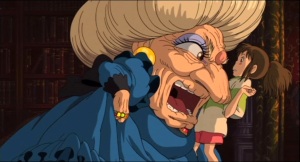 One of the things I love about Miyazaki is that he never sets up a simplistic face-off between good and evil. He knows we all have good and evil within us, and thus his “villains” have moments of kindness, and his heroes do things they regret.
One of the things I love about Miyazaki is that he never sets up a simplistic face-off between good and evil. He knows we all have good and evil within us, and thus his “villains” have moments of kindness, and his heroes do things they regret.
If the film sounds complicated, it’s because it is. This film runs just over two hours, but with its fast pace and a plethora of subplots Spirited Away feels like Miyazaki decided to challenge George Lucas at his own game of exotic adventure and whimsy. There are enough bizarre creatures here to make the cantina in Star Wars look boring. The depth and fertility of Miyazaki’s imagination leaves me stunned at every turn.
 Some will say that this film is too complex for children, and too scary. For small children, possibly. They could get lost in the intricate plot, and the monsters might scare them. I personally showed it to my kids starting at age 5 and up. But I think kids should be challenged to think through what they’re watching, and this is a story that provides great opportunities for discussion with grownups. Spirited Away is at times frightening, but it emphasizes the importance of an individual’s virtue, and affirms that the smallest of characters can make a big difference. It offers powerful displays of sacrificial love. And it, as I mentioned before, portrays “villains” who are redeemable and can be transformed by compassion and kindness.
Some will say that this film is too complex for children, and too scary. For small children, possibly. They could get lost in the intricate plot, and the monsters might scare them. I personally showed it to my kids starting at age 5 and up. But I think kids should be challenged to think through what they’re watching, and this is a story that provides great opportunities for discussion with grownups. Spirited Away is at times frightening, but it emphasizes the importance of an individual’s virtue, and affirms that the smallest of characters can make a big difference. It offers powerful displays of sacrificial love. And it, as I mentioned before, portrays “villains” who are redeemable and can be transformed by compassion and kindness.
Many Christians will probably berate me for my love of this film calling it occultic. But Miyazaki comes from a culture that is steeped in Shinto mythology and beliefs about the spirits of nature and of the dead. So of course, his story reflects such traditions and beliefs. But he is not “preaching” these ideas any more than Jiminy Cricket is preaching astrology when he croons about wishing upon a star. He is treating them as myth, as fantasy, and using them to illustrate lessons and morals that open-minded Christians will find quite similar to their own. The film makes no mention of “God” or any benevolent force which rules the world, but it does affirm the importance of personal virtues like: selflessness, sacrificial love, humility, friendship, compassion, and courage. People of any faith can read these characters as symbolic, and the story reflects powerful truths.
 One spirit in particular, No Face, appears at first to be gentle and friendly. But he becomes more and more mysterious, shifting between gentleness and violent destructive behavior. Eventually, we come to understand that he is a lonely spirit who seeks approval. When he is around greed and evil, he responds with greed and evil. But when he is offered friendship and unconditional love, he seems to try a better path. Chihiro has patience with him and her kindness reminds me of how Christ patiently endures with me in my own tendency to become self-absorbed. He waits patiently, always offering love, forgiveness, and direction to a better way. No Face is amazed at Chihiro’s virtue. And I came to hope that he would abandon his violence and follow Chihiro to a better life. This is just one of many such parables within a vast tapestry of interconnected stories.
One spirit in particular, No Face, appears at first to be gentle and friendly. But he becomes more and more mysterious, shifting between gentleness and violent destructive behavior. Eventually, we come to understand that he is a lonely spirit who seeks approval. When he is around greed and evil, he responds with greed and evil. But when he is offered friendship and unconditional love, he seems to try a better path. Chihiro has patience with him and her kindness reminds me of how Christ patiently endures with me in my own tendency to become self-absorbed. He waits patiently, always offering love, forgiveness, and direction to a better way. No Face is amazed at Chihiro’s virtue. And I came to hope that he would abandon his violence and follow Chihiro to a better life. This is just one of many such parables within a vast tapestry of interconnected stories.
All in all, this is an absolute must-see. And the bigger the screen the better. The colors are incredible, from shots of a magical train that skims across the sea, to fantastical gardens and intricately painted murals. Well, I’ve said my piece. What is your favorite Animated movie? Do you love Miyazaki’s work as much as I do, or do you have another opinion. I’d love to hear your thoughts in the comments below or on Twitter or Facebook.
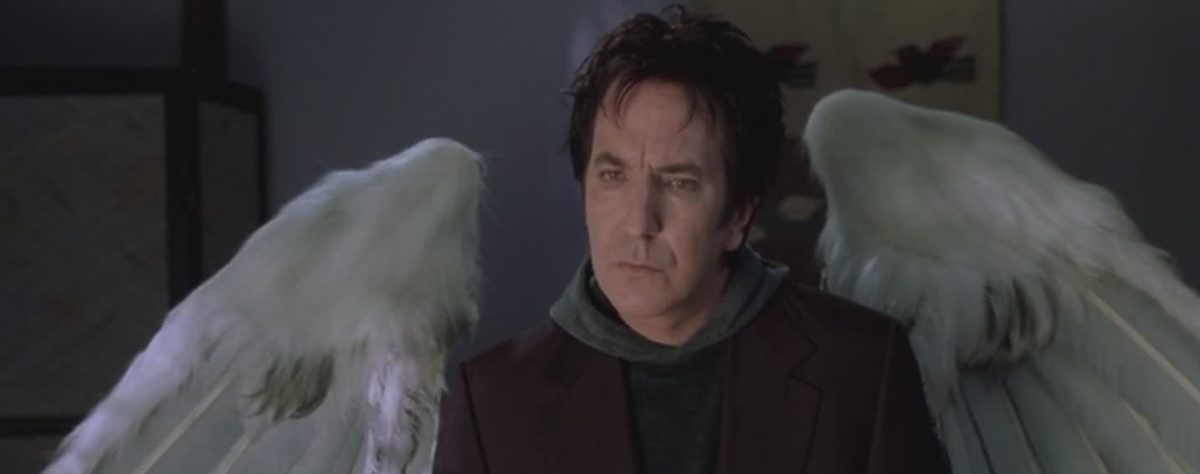




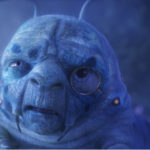

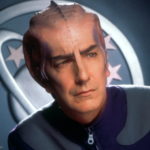

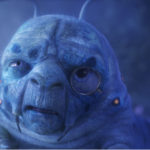
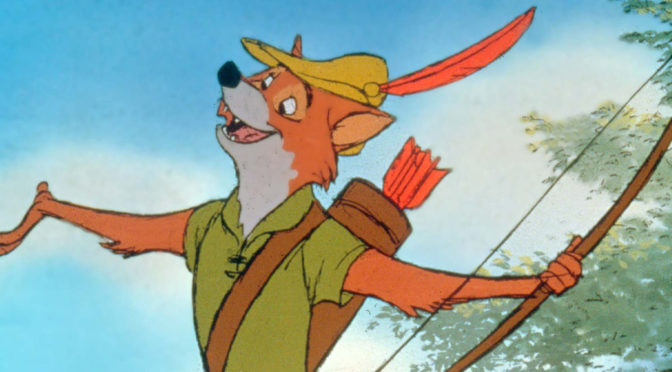
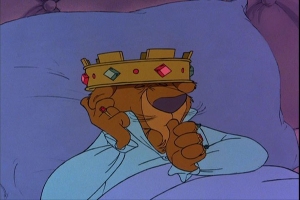 Looking back, as an adult and a film snob, I can see that the picture is notorious for its corner-cutting animation, it simply doesn’t have the sparkling hand-drawn detail of earlier Disney masterpieces, or the glitzy sheen of the latter ones. It’s certainly one of the more crudely-drawn productions of the company. But even when you stack up the complaints lobbed at this incarnation of the Robin Hood tale, they really don’t matter, because in the end we get a richly entertaining good time, and I’m glad to say that this film is just as captivating to my children as it was to me.
Looking back, as an adult and a film snob, I can see that the picture is notorious for its corner-cutting animation, it simply doesn’t have the sparkling hand-drawn detail of earlier Disney masterpieces, or the glitzy sheen of the latter ones. It’s certainly one of the more crudely-drawn productions of the company. But even when you stack up the complaints lobbed at this incarnation of the Robin Hood tale, they really don’t matter, because in the end we get a richly entertaining good time, and I’m glad to say that this film is just as captivating to my children as it was to me.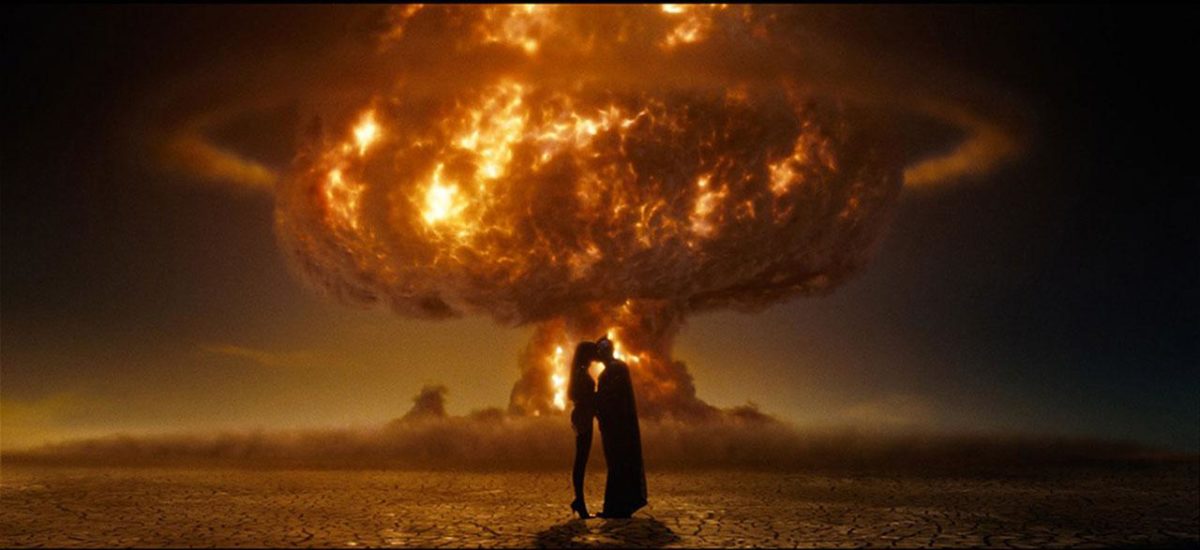
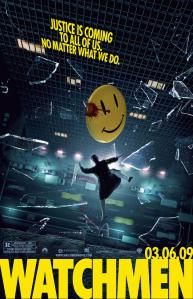

 Being a dad, it seems like I watch more animated movies than any other type. And since I am a film snob, I can’t stand to endlessly re-watch sub-par movies the way that I see so many parents do. Just because Cars is my kids’ favorite Pixar movie, that doesn’t mean that I am going to put it on every time they ask to watch a movie. Although they would be happy with that, I would go insane. And even if it was a good movie, it would lose some of its magic after seeing it twice a week for 3 years. I am constantly looking for good animated films to share with my family. That passion, along with my general love for film, led me to the breathtaking and impressive canon of Japanese hand-drawn animation director
Being a dad, it seems like I watch more animated movies than any other type. And since I am a film snob, I can’t stand to endlessly re-watch sub-par movies the way that I see so many parents do. Just because Cars is my kids’ favorite Pixar movie, that doesn’t mean that I am going to put it on every time they ask to watch a movie. Although they would be happy with that, I would go insane. And even if it was a good movie, it would lose some of its magic after seeing it twice a week for 3 years. I am constantly looking for good animated films to share with my family. That passion, along with my general love for film, led me to the breathtaking and impressive canon of Japanese hand-drawn animation director  But Miyazaki is a glowing exception. His animation has an attention to detail that rivals the exacting standards of a company like Pixar. His intense yet delicate shading of colors would make his works of art more at home in a fine art gallery than in the Sunday comics. Miyazaki also has a great sense of humor, a gift for poetic storytelling, and a taste for adventure. His beautiful children’s movie, My Neighbor Totoro, is a charming and deeply affecting look at how a child’s imagination helps her endure a time of private fear and sadness. His most recent work, Ponyo, is a beautiful story of the transforming power of love. Princess Mononoke, is a powerful, sprawling epic about the need for humankind to respect and live in harmony with the environment. And that is a message that people of all faiths should proclaim.
But Miyazaki is a glowing exception. His animation has an attention to detail that rivals the exacting standards of a company like Pixar. His intense yet delicate shading of colors would make his works of art more at home in a fine art gallery than in the Sunday comics. Miyazaki also has a great sense of humor, a gift for poetic storytelling, and a taste for adventure. His beautiful children’s movie, My Neighbor Totoro, is a charming and deeply affecting look at how a child’s imagination helps her endure a time of private fear and sadness. His most recent work, Ponyo, is a beautiful story of the transforming power of love. Princess Mononoke, is a powerful, sprawling epic about the need for humankind to respect and live in harmony with the environment. And that is a message that people of all faiths should proclaim. Spirited Away is a coming of age story of a little girl named Chihiro, who gets lost in a wonderland of spirits and witches, and her quest to find a way to break the curse that has transformed her parents so they can return home. Her only friend in this world is a mysterious boy named Haku who helps her to survive. Eventually we come to hope that Chihiro, her parents, and Haku will all eventually break away from the harsh tyranny of the powerful and dictatorial witch Yubaba.
Spirited Away is a coming of age story of a little girl named Chihiro, who gets lost in a wonderland of spirits and witches, and her quest to find a way to break the curse that has transformed her parents so they can return home. Her only friend in this world is a mysterious boy named Haku who helps her to survive. Eventually we come to hope that Chihiro, her parents, and Haku will all eventually break away from the harsh tyranny of the powerful and dictatorial witch Yubaba. One of the things I love about Miyazaki is that he never sets up a simplistic face-off between good and evil. He knows we all have good and evil within us, and thus his “villains” have moments of kindness, and his heroes do things they regret.
One of the things I love about Miyazaki is that he never sets up a simplistic face-off between good and evil. He knows we all have good and evil within us, and thus his “villains” have moments of kindness, and his heroes do things they regret. Some will say that this film is too complex for children, and too scary. For small children, possibly. They could get lost in the intricate plot, and the monsters might scare them. I personally showed it to my kids starting at age 5 and up. But I think kids should be challenged to think through what they’re watching, and this is a story that provides great opportunities for discussion with grownups. Spirited Away is at times frightening, but it emphasizes the importance of an individual’s virtue, and affirms that the smallest of characters can make a big difference. It offers powerful displays of sacrificial love. And it, as I mentioned before, portrays “villains” who are redeemable and can be transformed by compassion and kindness.
Some will say that this film is too complex for children, and too scary. For small children, possibly. They could get lost in the intricate plot, and the monsters might scare them. I personally showed it to my kids starting at age 5 and up. But I think kids should be challenged to think through what they’re watching, and this is a story that provides great opportunities for discussion with grownups. Spirited Away is at times frightening, but it emphasizes the importance of an individual’s virtue, and affirms that the smallest of characters can make a big difference. It offers powerful displays of sacrificial love. And it, as I mentioned before, portrays “villains” who are redeemable and can be transformed by compassion and kindness. One spirit in particular, No Face, appears at first to be gentle and friendly. But he becomes more and more mysterious, shifting between gentleness and violent destructive behavior. Eventually, we come to understand that he is a lonely spirit who seeks approval. When he is around greed and evil, he responds with greed and evil. But when he is offered friendship and unconditional love, he seems to try a better path. Chihiro has patience with him and her kindness reminds me of how Christ patiently endures with me in my own tendency to become self-absorbed. He waits patiently, always offering love, forgiveness, and direction to a better way. No Face is amazed at Chihiro’s virtue. And I came to hope that he would abandon his violence and follow Chihiro to a better life. This is just one of many such parables within a vast tapestry of interconnected stories.
One spirit in particular, No Face, appears at first to be gentle and friendly. But he becomes more and more mysterious, shifting between gentleness and violent destructive behavior. Eventually, we come to understand that he is a lonely spirit who seeks approval. When he is around greed and evil, he responds with greed and evil. But when he is offered friendship and unconditional love, he seems to try a better path. Chihiro has patience with him and her kindness reminds me of how Christ patiently endures with me in my own tendency to become self-absorbed. He waits patiently, always offering love, forgiveness, and direction to a better way. No Face is amazed at Chihiro’s virtue. And I came to hope that he would abandon his violence and follow Chihiro to a better life. This is just one of many such parables within a vast tapestry of interconnected stories. You would think that with 20 years to work on a worthy follow-up to the Indiana Jones Trilogy that Steven Spielberg and his collaborator George Lucas could create an entertaining and exciting film. However, it seems that instead of becoming sweeter with time, this one just became rotten. In Indiana Jones and The Kingdom of the Crystal Skull, we see an elderly Indy (or should I say Henry because he is rarely called “Indiana” or “Indy” in this film) in his baggy grandpa pants with locks of grey-white hair peeking out under a crisp and rarely-dirty brown fedora you really don’t get the feeling that you’re watching anything historic. This is a movie that obviously misunderstood its audience, it’s exactly the type of summer blockbuster developed to make money at all costs: things blow up; there are aliens; and an unnecessary youthful sidekick.
You would think that with 20 years to work on a worthy follow-up to the Indiana Jones Trilogy that Steven Spielberg and his collaborator George Lucas could create an entertaining and exciting film. However, it seems that instead of becoming sweeter with time, this one just became rotten. In Indiana Jones and The Kingdom of the Crystal Skull, we see an elderly Indy (or should I say Henry because he is rarely called “Indiana” or “Indy” in this film) in his baggy grandpa pants with locks of grey-white hair peeking out under a crisp and rarely-dirty brown fedora you really don’t get the feeling that you’re watching anything historic. This is a movie that obviously misunderstood its audience, it’s exactly the type of summer blockbuster developed to make money at all costs: things blow up; there are aliens; and an unnecessary youthful sidekick. The other aspect of the film that disappointed me was the role that extra-terrestrials play. The original trilogy uses religious artifacts as the treasure the Indy is hunting. But as with the abominable Star Trek prequels that George Lucas thrust upon audiences, all of the religion and mysticism was replaced by science-fiction. Why don’t film-makers understand that audiences want to encounter something inexplicable in the theater. We don’t want midichlorians to give a scientific explanation of the force or science to replace our religion. The presence of the aliens is strong, but there is no dialogue between the two parties, much like Spielberg’s Close Encounters of the Third Kind.
The other aspect of the film that disappointed me was the role that extra-terrestrials play. The original trilogy uses religious artifacts as the treasure the Indy is hunting. But as with the abominable Star Trek prequels that George Lucas thrust upon audiences, all of the religion and mysticism was replaced by science-fiction. Why don’t film-makers understand that audiences want to encounter something inexplicable in the theater. We don’t want midichlorians to give a scientific explanation of the force or science to replace our religion. The presence of the aliens is strong, but there is no dialogue between the two parties, much like Spielberg’s Close Encounters of the Third Kind. Ultimately, Indiana Jones and the Kingdom of the Crystal Skull is a film that, while not entirely bad, is nowhere near worthy of its lofty pedigree. As generic action films go, it may have provided some level of entertainment in the vein of National Treasure..But with the attachment of “Indiana Jones” to the title and the involvement of Harrison Ford, George Lucas and Steven Spielberg my expectations were raised and my standards were set to a level that these individuals can sadly no longer meet.
Ultimately, Indiana Jones and the Kingdom of the Crystal Skull is a film that, while not entirely bad, is nowhere near worthy of its lofty pedigree. As generic action films go, it may have provided some level of entertainment in the vein of National Treasure..But with the attachment of “Indiana Jones” to the title and the involvement of Harrison Ford, George Lucas and Steven Spielberg my expectations were raised and my standards were set to a level that these individuals can sadly no longer meet. The most difficult part of writing a review for Monster’s Inc. Is that it is an animated film and we tend to treat these movies simply for their entertainment value for kids. But I think that animated films can have great value apart from mindless entertainment. And that is the area in which Pixar films in recent years have excelled above their peers in the animation business.
The most difficult part of writing a review for Monster’s Inc. Is that it is an animated film and we tend to treat these movies simply for their entertainment value for kids. But I think that animated films can have great value apart from mindless entertainment. And that is the area in which Pixar films in recent years have excelled above their peers in the animation business. Monster’s Inc. at its core is the inversion of a horror film. Normally, kids are wetting their beds at the idea that monsters live in their closets and are going to come out to scare them. Monsters Inc. simply admits this epidemic of home invasion as fact and then goes inside the closet to tell the story from the monsters point of view. It turns out that monsters don’t particularly enjoy scaring children, it is simply their job. Monstropolis (the Narnia on the other end of these impressionable children’s wardrobes) runs on the screams of children. But because human children are flooded with violent movies and television shows at increasingly younger ages, they are getting harder to scare and consequently Monstropolis has a scream shortage.
Monster’s Inc. at its core is the inversion of a horror film. Normally, kids are wetting their beds at the idea that monsters live in their closets and are going to come out to scare them. Monsters Inc. simply admits this epidemic of home invasion as fact and then goes inside the closet to tell the story from the monsters point of view. It turns out that monsters don’t particularly enjoy scaring children, it is simply their job. Monstropolis (the Narnia on the other end of these impressionable children’s wardrobes) runs on the screams of children. But because human children are flooded with violent movies and television shows at increasingly younger ages, they are getting harder to scare and consequently Monstropolis has a scream shortage. Add to that two of the most likable characters in all of Pixar’s movies, second only to Woody and Buzz, and you’ve got a movie that went toe-to-toe with Shrek, and by all counts lost that battle. But I would invite you to rematch both films and decide for yourself which has aged better. I think that Monsters Inc. could do equally well today, but I’m not sure I could say that about Shrek.
Add to that two of the most likable characters in all of Pixar’s movies, second only to Woody and Buzz, and you’ve got a movie that went toe-to-toe with Shrek, and by all counts lost that battle. But I would invite you to rematch both films and decide for yourself which has aged better. I think that Monsters Inc. could do equally well today, but I’m not sure I could say that about Shrek. Anymore, it is pointless to mention the superb animation that is present in these movies. But in its time, the computer animation rendering of every frame featuring Sully took 11 hours to complete because the movement of each of his 2,320,413 hairs. With a frame rate of 24 fps that is nearly a month of processor time to create a single second of footage.
Anymore, it is pointless to mention the superb animation that is present in these movies. But in its time, the computer animation rendering of every frame featuring Sully took 11 hours to complete because the movement of each of his 2,320,413 hairs. With a frame rate of 24 fps that is nearly a month of processor time to create a single second of footage.
 So when the folks at Pixar brought the script and some storyboards for what would eventually become Toy Story 2 to Disney, they made the smart decision to pour their resources into this sequel. Most sequels simply dilute the story and characters like too much water added to good Scotch. But not all sequels are bad. The best sequels take the original film at face value and then seamlessly expand from there with a movie that stands on it’s own merit instead of being propped up simply by the success of it’s predecessor. For instance, I loved Terminator II: Judgment Day from the moment I first watched it, but it took me several years to build up a desire to watch the original Terminator.
So when the folks at Pixar brought the script and some storyboards for what would eventually become Toy Story 2 to Disney, they made the smart decision to pour their resources into this sequel. Most sequels simply dilute the story and characters like too much water added to good Scotch. But not all sequels are bad. The best sequels take the original film at face value and then seamlessly expand from there with a movie that stands on it’s own merit instead of being propped up simply by the success of it’s predecessor. For instance, I loved Terminator II: Judgment Day from the moment I first watched it, but it took me several years to build up a desire to watch the original Terminator. My kids love it because even though it is now over 10 years old it looks great with an attention to detail that Pixar has become known for. The colors and textures are light years (no pun intended) better than the original, and that’s saying something because it was beautiful and the improvement came in just 4 year’s time. Also, my kids are continuously quoting lines from these movies, and I believe it’s because the movie isn’t pandering and condescending to “their level.” The dialogue is incredible for a kids movie and it is carried by a voice cast that has expanded its diversity to include Joan Cusack. But my kids watch it over and over and hear different things every time. The story is easy enough to understand that you could follow it even if the sound on your TV went out, but everything about the story is enhanced because of the humorous and touching script.
My kids love it because even though it is now over 10 years old it looks great with an attention to detail that Pixar has become known for. The colors and textures are light years (no pun intended) better than the original, and that’s saying something because it was beautiful and the improvement came in just 4 year’s time. Also, my kids are continuously quoting lines from these movies, and I believe it’s because the movie isn’t pandering and condescending to “their level.” The dialogue is incredible for a kids movie and it is carried by a voice cast that has expanded its diversity to include Joan Cusack. But my kids watch it over and over and hear different things every time. The story is easy enough to understand that you could follow it even if the sound on your TV went out, but everything about the story is enhanced because of the humorous and touching script. When my kids watched The Empire Strikes Back for the first time and Vader spills his big secret, one of my kids said it’s just like Toy Story. Speaking of twists, though I can’t remember the first time I watched this film, I am willing to bet that I was surprised at the devious selfishness of Stinky Pete. And even though we are used to movies like this now, this one is simply action packed, with at least 5 distinct chase scenes, two shootouts, several covert operations, and epic surroundings for all of the above make this movie one that I find it hard to rip myself away from.
When my kids watched The Empire Strikes Back for the first time and Vader spills his big secret, one of my kids said it’s just like Toy Story. Speaking of twists, though I can’t remember the first time I watched this film, I am willing to bet that I was surprised at the devious selfishness of Stinky Pete. And even though we are used to movies like this now, this one is simply action packed, with at least 5 distinct chase scenes, two shootouts, several covert operations, and epic surroundings for all of the above make this movie one that I find it hard to rip myself away from. It would have been impossible had Pixar not broken ground in Toy Story 2 with the chase through the airport baggage area. Also, think of as many animated films as you can that have made you want to both laugh and cry, applaud and think, remember and wonder. I would be willing to wager that almost all of those films are from the storytelling magicians at Pixar. They just have the ability and lack of inhibition that lets them expertly dive into issues that most animated or childrens’ films won’t touch. Issues like loss, rejection, abandonment, fear, identity, purpose, and love.
It would have been impossible had Pixar not broken ground in Toy Story 2 with the chase through the airport baggage area. Also, think of as many animated films as you can that have made you want to both laugh and cry, applaud and think, remember and wonder. I would be willing to wager that almost all of those films are from the storytelling magicians at Pixar. They just have the ability and lack of inhibition that lets them expertly dive into issues that most animated or childrens’ films won’t touch. Issues like loss, rejection, abandonment, fear, identity, purpose, and love. Who knew that a simple movie about the secret lives of toys could go so deep as to teach its viewers something profound about themselves. That is the art of film-making, the magic of Pixar, and the reason why I can’t stop watching movies. Because movies have this ability in common with Scripture. I love Scripture because it can destroy me one minute as it reveals my sin, then restore me as it reveals my Savior. And I keep watching movies because I hope that the next one will cut me open to my core and teach me a little bit more about myself. If my kids watch the Toy Story movies and want to act like Woody or Buzz, that is fine with me, because both characters exemplify the type of behavior and strength and purity of character that I wish everyone had and pray that my children will develop. I can’t say that about every cartoon character. The thing that makes Toy Story great is the desire it creates in its viewers to not only observe greatness but to pursue and attain it.
Who knew that a simple movie about the secret lives of toys could go so deep as to teach its viewers something profound about themselves. That is the art of film-making, the magic of Pixar, and the reason why I can’t stop watching movies. Because movies have this ability in common with Scripture. I love Scripture because it can destroy me one minute as it reveals my sin, then restore me as it reveals my Savior. And I keep watching movies because I hope that the next one will cut me open to my core and teach me a little bit more about myself. If my kids watch the Toy Story movies and want to act like Woody or Buzz, that is fine with me, because both characters exemplify the type of behavior and strength and purity of character that I wish everyone had and pray that my children will develop. I can’t say that about every cartoon character. The thing that makes Toy Story great is the desire it creates in its viewers to not only observe greatness but to pursue and attain it.  This movie was released when I was ten years-old, and I remember wanting to see it not so much because of the animation technique or the big names attached to it, but because I thought the
This movie was released when I was ten years-old, and I remember wanting to see it not so much because of the animation technique or the big names attached to it, but because I thought the  As I watched this magical film again today, I was struck by a few observations.
As I watched this magical film again today, I was struck by a few observations. Do you see the connection? Jack Skellington (The Pumpkin King) is revered in his native Halloweentown, but he has grown tired of the same old routine. While wandering through the forest, he stumbles across and opens a portal to Christmastown. He is intrigued and impressed by what he feels in this magical place. Although devoid of any reference to the Christian origins of Christmas, besides a quote from the kidnapped “Sandy Claws” who shouts, “Haven’t you ever heard of peace on earth, good will towards men?” Jack’s feelings aren’t totally dissimilar to the emotions that accompany the new birth. Much like Jack Skellington, our lives are empty and we continually search for something more until we stumble across the meaning of Christmas. Sadly, the true meaning of Christmas is never unearthed but it still raises all sorts of ideas about the comparison of the death symbolized in Halloween to the life that is found in Christmas. Our lives before Jesus are the real nightmare before Christmas. Our lives were filled with suffering then Jesus was born and everything really did change.
Do you see the connection? Jack Skellington (The Pumpkin King) is revered in his native Halloweentown, but he has grown tired of the same old routine. While wandering through the forest, he stumbles across and opens a portal to Christmastown. He is intrigued and impressed by what he feels in this magical place. Although devoid of any reference to the Christian origins of Christmas, besides a quote from the kidnapped “Sandy Claws” who shouts, “Haven’t you ever heard of peace on earth, good will towards men?” Jack’s feelings aren’t totally dissimilar to the emotions that accompany the new birth. Much like Jack Skellington, our lives are empty and we continually search for something more until we stumble across the meaning of Christmas. Sadly, the true meaning of Christmas is never unearthed but it still raises all sorts of ideas about the comparison of the death symbolized in Halloween to the life that is found in Christmas. Our lives before Jesus are the real nightmare before Christmas. Our lives were filled with suffering then Jesus was born and everything really did change.